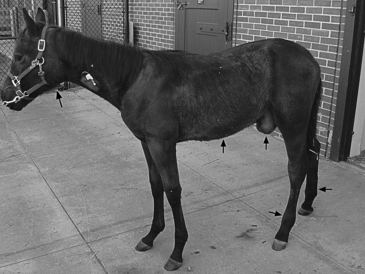CHAPTER 38 Lawsonia intracellularis Enteropathy in Foals
Proliferative enteropathy is a recently described infectious disease of the intestinal tract of weanling foals that has been associated with lethargy, poor body condition, weight loss, hypoproteinemia, and subcutaneous edema.
PATHOGENESIS
Hypoproteinemia, in particular hypoalbuminemia, is likely the result of a protein-losing enteropathy that arises from increased intestinal permeability, decreased absorption of amino acids, and systemic protein catabolism. Hypoproteinemia leads to low plasma oncotic pressure and formation of subcutaneous edema. Poor nutrient absorption and concurrent protein loss are likely responsible for the failure to thrive and weight loss. Anemia develops in some affected foals and appears to result from the lack of nutrients and a systemic response to the disease. There is no evidence that L. intracellularis infects tissues other than those of the intestinal tract. It is unclear whether immunosuppression plays a role in the pathogenesis of this disease in foals, but it is believed that stress is a predisposing factor.
Clinical signs
The classic clinical presentation of L. intracellularis enteropathy involves weanling foals aged 3 to 12 months, with most animals approximately 5 months old. Common clinical findings include lethargy; anorexia; weight loss; poor body condition with potbellied abdomen; poor hair coat; subcutaneous edema in the abdomen, prepuce, legs, and head; and dehydration, diarrhea, and colic (Figure 38-1). Secondary gastrointestinal, respiratory, and skin infections are frequent. A procoagulant state, including thrombophlebitis from decreased antithrombin III activity has been reported. Sudden death is rare but does occur.




